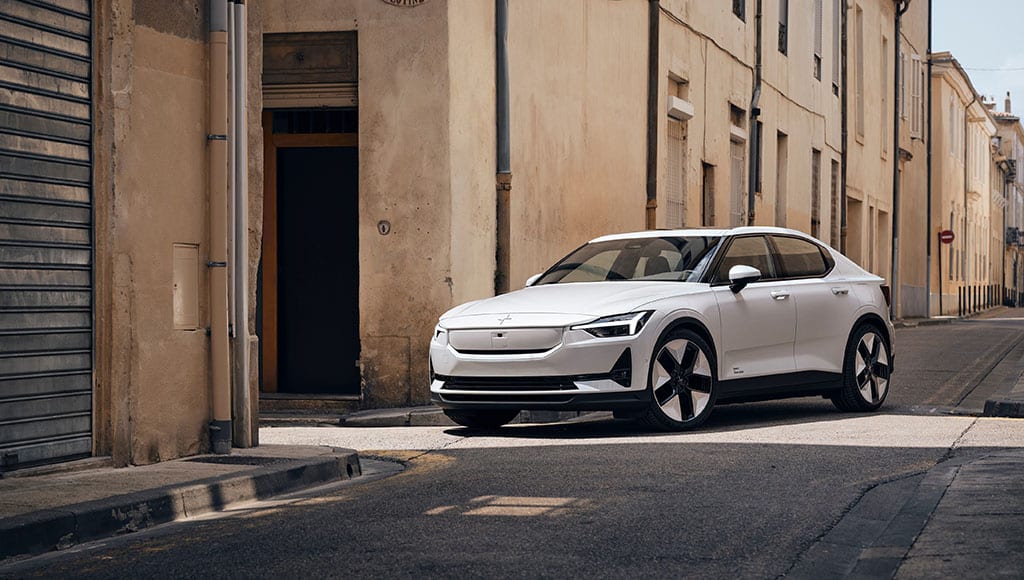I may have used that title before, but it just seemed too good to pass on with a car called Polestar that is, on top of everyting, actually quite good.
I wish the Polestar 2 had an engine in it. I am sorry Polestar, I know you are very eco-conscious, but I had to say it.
I mean, look at this. Is there a classier car from this decade? Something as beautiful as it is understated. This is what good design used to be – what it should be.
If you look at the great creations from names like Charles and Ray Eames, Achille Castiglioni or Arne Jacobsen, there is nothing flashy about them. The great thing about the biggest design genius is that their design seems natural, like things are meant to be just as they designed them – as if they discovered those shapes, not imagined them.
To me, the Polestar 2 is a car that holds classical design cues and mixes them with modern propulsion technology. A bit like, if the Eames’s grandchildren were going to design a car, this is what they would come up with. Simple. Perfectly proportioned. Organic. Proof the automobile does not have to be shouty to be noticed. Yes, it’s not easy these days, but when it happens, it’s magical. I tip my hat off to you, Mr. Thomas Ingenlath.
Some people say it’s a crossover hatchback, but it absolutely is not. It’s a saloon. In fact, it’s the epitome of a modern saloon. Higher riding yes, but the three-box shape is undeniably present.
The 2 began life as a Volvo concept car named 40.2 and was first shown to the public in 2016. The story goes that when Volvo’s top managers looked at the car on a motor show stand next to the other production models, they had an epiphany. This car was so special it would be the bedrock of an entire new company, one which would offer only sustainable products, both in production and in actual everyday use.

They presented the business case to Volvo’s parent company Geely and, well, the rest is history. Polestar was actually born because the 2 looked this good.
As a more luxurious offering with an upmarket positioning, think Toyota and Lexus or Nissan and Infinity and it’s easy to understand what the Swedes are trying to accomplish here.
The 2 is the entry model to Polestar world and I was lent the Long Range Single-Motor version, i.e., not only the most interesting Polestar 2, but the most interesting Polestar, period. I am not an SUV kind of guy and the 3 and 4 fit into that category. And at much higher prices.
If you must have a BEV as your only car, let it be a Polestar 2, the classiest battery-powered vehicle of them all. A design for the ages, in my opinion
The 2 was launched in 2020 and underwent a substantial update in late 2023. Some technical changes included a new nickel manganese cobalt battery pack, which added battery capacity and electric range, as well as a new motor technology that improved both performance and efficiency.
But that’s not all. The most incredible thing about the changes made to the car is the fact it moved from a front-wheel drive to a rear-wheel drive layout. Yes, really. The same car. There must be something special in the water in Sweden.
Why and how? Well, simple: the engineers found a way to improve range and running efficiency with the new configuration and on the same CMA platform, without having to change the cabin and body of the car. Genius.
The Polestar 2 is built in China to European standards, something I can attest to. It feels beautifully built and quality is very high. Sitting inside while negotiating the urban traffic is weirdly satisfying. The car is super smooth and comfortable, isolating passengers from the noise, the cold, the heat and, if needed, even the troubles of everyday life.
My time with the Polestar coincided with an important meeting I had in Leiria, some 150km away from home. I left it charging overnight and departed with a full 100% of range available, the onboard computer displaying 530km. I told myself I had to adapt my driving to the car and decided I didn’t want to stop at any fast-charging stations along the way.
And thus, I never went above 110km/h. Boring? Yes, definitely, and I still do not want any electric cars in my life, but the truth is the 2 took me there and back, with a few detours along the planned route, for a total of 410km with … drums rolling, please … 110km left on the battery as I parked back home at night.
So that’s only 10km from the indicated range when I set off. Well done, sir. Or car. Within a certain set of conditions, it really works. And if you are willing to live with those conditions, the Polestar has almost everything in its favour: looks better than anything else, the interior is a great place to be, the driving experience is enjoyable and the ride is very, very good.
As for prices, the Long Range Single Motor with 299 horsepower and up to 659 km of range starts at €56,900, whereas the Standard Range and its 272 hp and 534 km of range is €53,400. The Dual Motor is €60,900, bringing 421 hp and 596 km of range. You decide on value, as there are too many subjective considerations to be made.
I end as I began: I wish it had an engine in it. I am absolutely sure I would have one, in white, in the garage by now.
Motoring Trade | Business, Services, Marketplace – click here


























